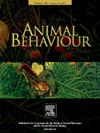Foraging response of bluegill Lepomis macrochirus to microplastics and subsequent impacts on swimming performance
IF 2.3
2区 生物学
Q2 BEHAVIORAL SCIENCES
引用次数: 0
Abstract
Microplastics are an emerging threat to aquatic and terrestrial species, and growing evidence suggests a suite of negative impacts, including reduced food consumption and direct physiological effects. Uptake of microplastics by animals can occur passively through accidental ingestion (i.e. fish swimming through contaminated water and taking microplastics into their buccal cavity/gills), or through active selection and consumption of particles. The rate of active plastic consumption for any animal depends on how well it can recognize and avoid eating the plastic. This likely has important impacts on the animal’s health and fitness, with subsequent impacts on reproductive fitness. In this study we explored the willingness of bluegill, Lepomis macrochirus, to directly consume microplastics (small, easily consumable pieces of high-density polyethylene bag films or polypropylene rope fibres) and whether this varied with continued exposure over time. Wild-caught bluegill were stocked in groups of three or six individuals in 37-litre aquaria and offered food (controls) or microplastics followed by food over a period of 4–6 days. Results showed that direct consumption of microplastics declined over time while foraging on food increased, indicating learned avoidance of microplastics. Foraging was impacted by plastic type, with bluegill more likely to forage on films than on fibres. Following group testing, each fish underwent an individual test for swimming endurance in a modified swim apparatus; however, no significant differences were found in swimming performance between treatments. Our results add to the growing literature revealing how animals, including fish, may actively consume microplastics and the potential effects of that exposure.
大蓝鳃鱼对微塑料的觅食反应及其对游泳性能的影响
微塑料对水生和陆生物种构成了新的威胁,越来越多的证据表明,它会产生一系列负面影响,包括减少食物消耗和直接的生理影响。动物对微塑料的吸收可以通过意外摄入被动发生(即鱼类在受污染的水中游泳并将微塑料带入其口腔/鳃),或通过主动选择和消耗颗粒。任何动物主动消耗塑料的速度取决于它识别和避免食用塑料的能力。这可能对动物的健康和适应性产生重要影响,进而对生殖适应性产生影响。在这项研究中,我们探讨了蓝鳃鱼(Lepomis macrochirus)直接摄入微塑料(高密度聚乙烯袋膜或聚丙烯绳纤维的小块、易消耗的碎片)的意愿,以及这种意愿是否会随着持续接触的时间而变化。在37升的水族箱中,将野生蓝鳃鱼以3或6个人为一组放养,并在4-6天内提供食物(对照)或微塑料,然后再提供食物。结果表明,随着时间的推移,微塑料的直接摄入量下降,而觅食食物的数量增加,表明学会了避免微塑料。觅食受到塑料类型的影响,蓝鳃鱼更可能在薄膜上觅食,而不是在纤维上觅食。在群体测试之后,每条鱼在改良的游泳装置中进行了游泳耐力的单独测试;然而,在不同的治疗组中,游泳成绩没有显著差异。我们的研究结果增加了越来越多的文献,揭示了包括鱼类在内的动物如何积极消耗微塑料以及这种暴露的潜在影响。
本文章由计算机程序翻译,如有差异,请以英文原文为准。
求助全文
约1分钟内获得全文
求助全文
来源期刊

Animal Behaviour
生物-动物学
CiteScore
4.60
自引率
8.00%
发文量
236
审稿时长
10.2 weeks
期刊介绍:
Growing interest in behavioural biology and the international reputation of Animal Behaviour prompted an expansion to monthly publication in 1989. Animal Behaviour continues to be the journal of choice for biologists, ethologists, psychologists, physiologists, and veterinarians with an interest in the subject.
 求助内容:
求助内容: 应助结果提醒方式:
应助结果提醒方式:


